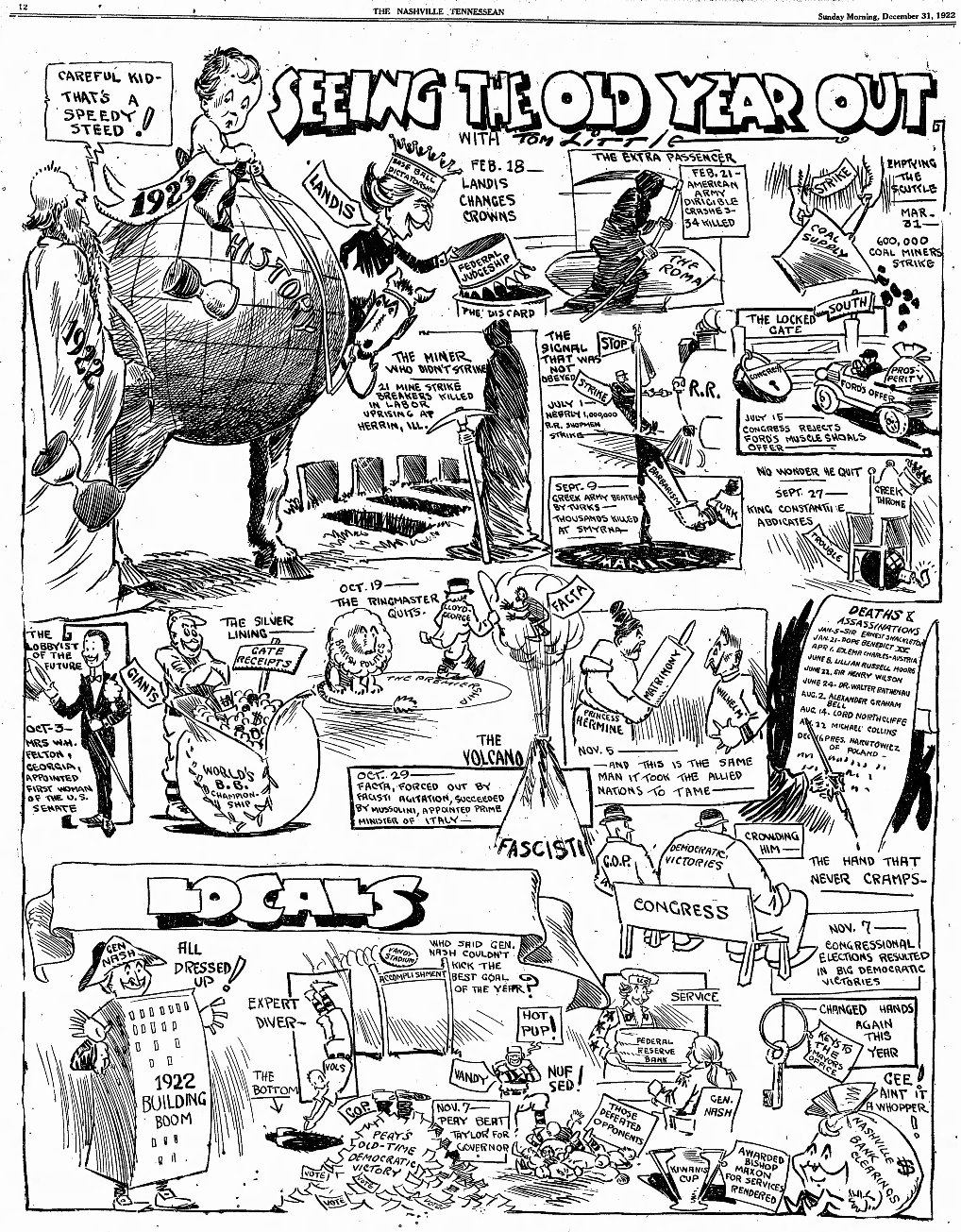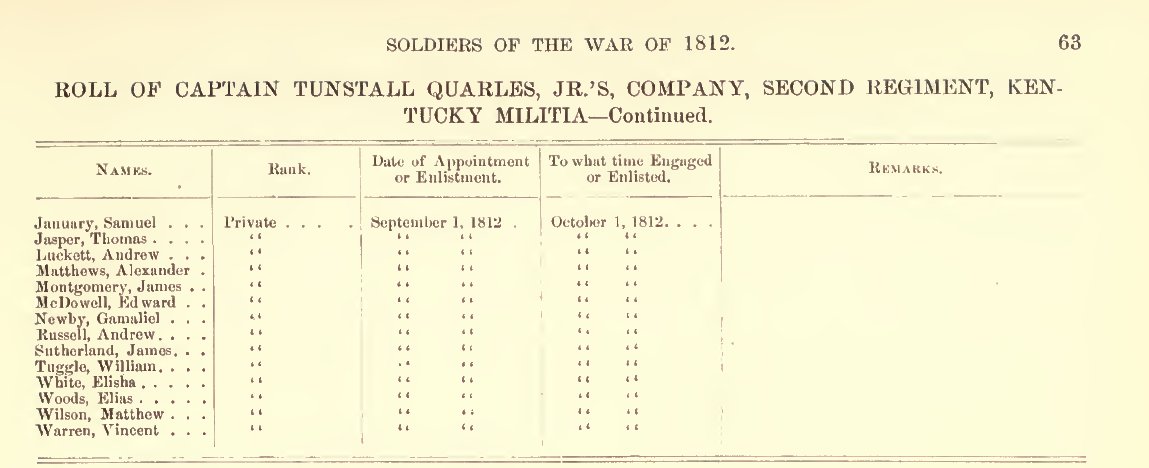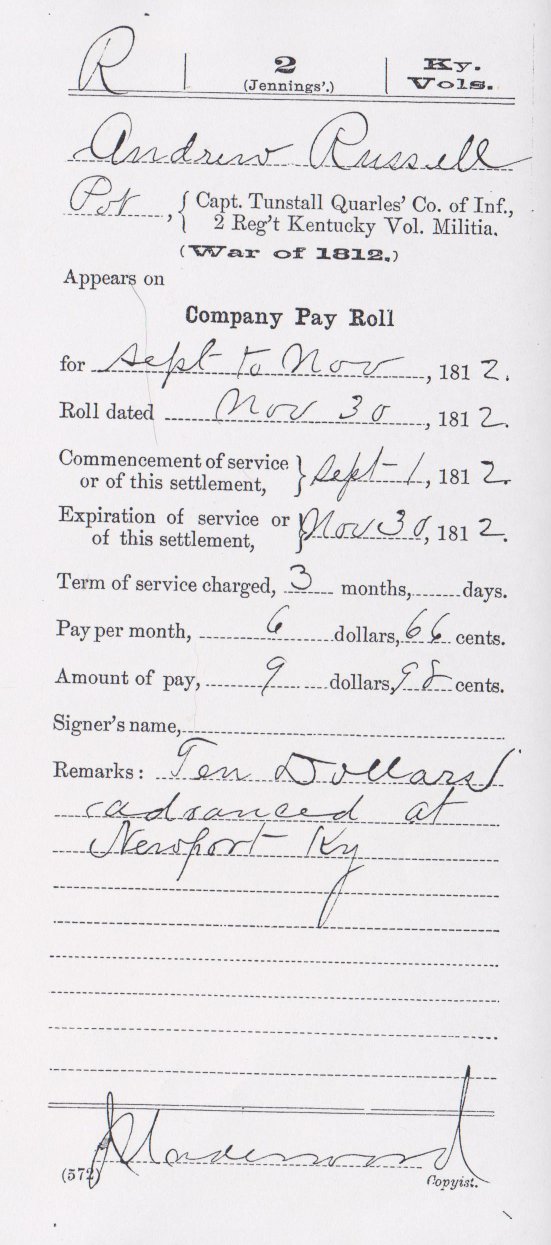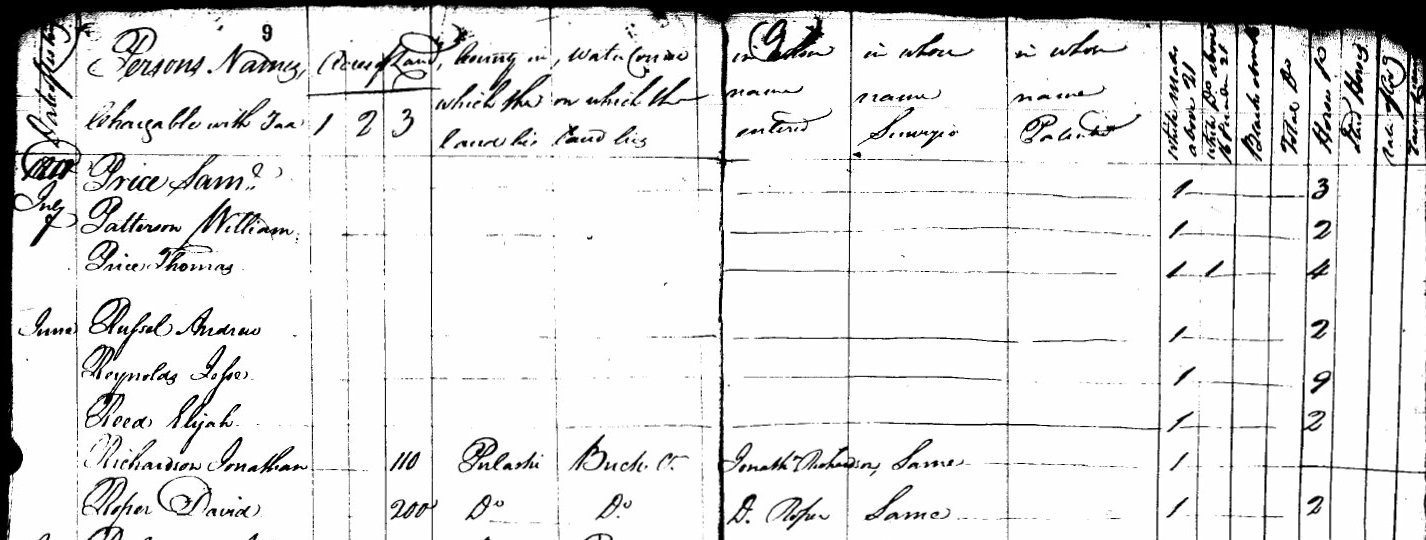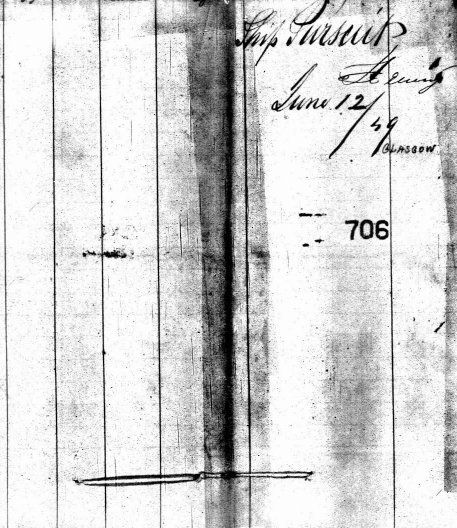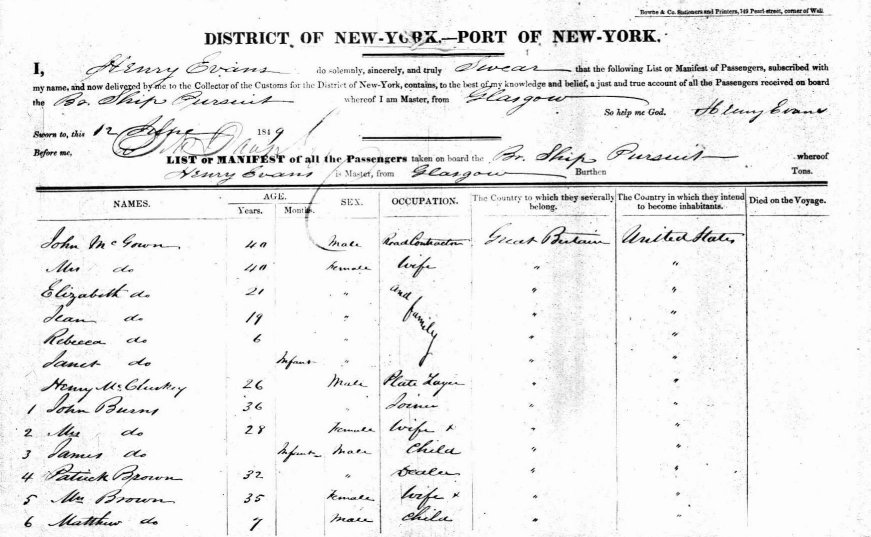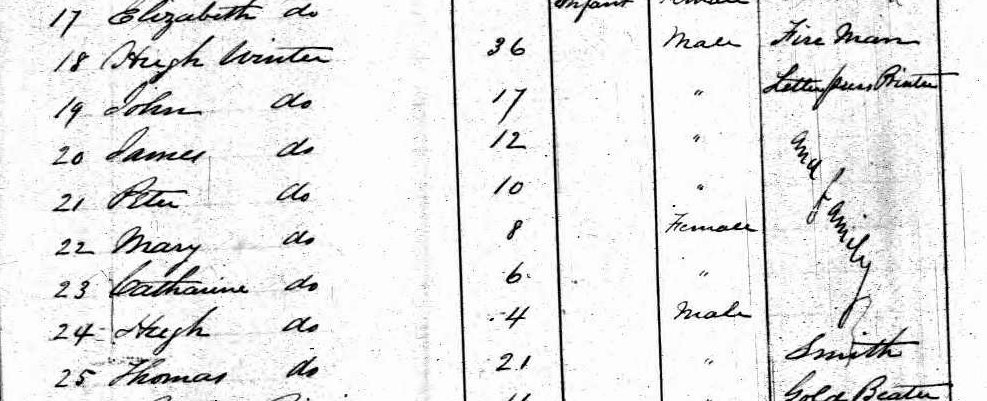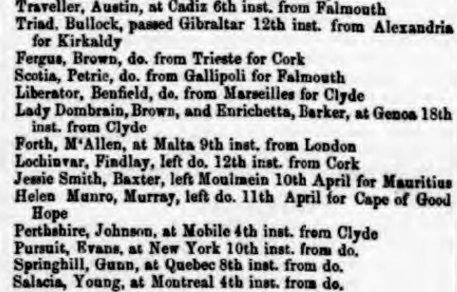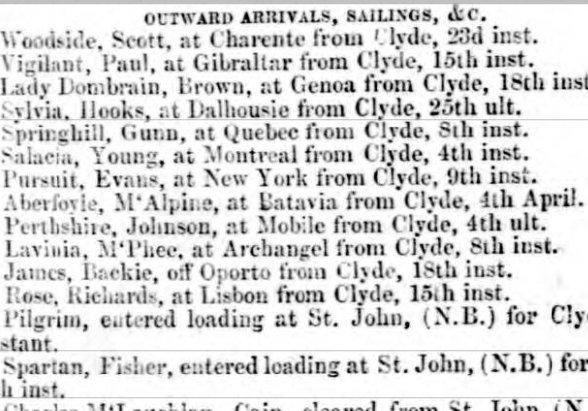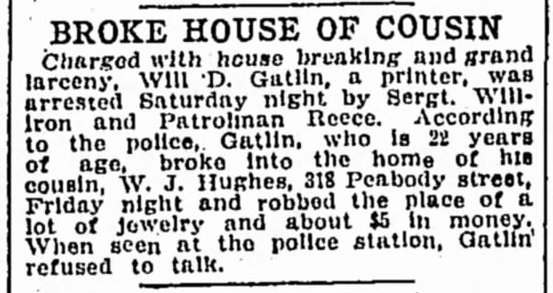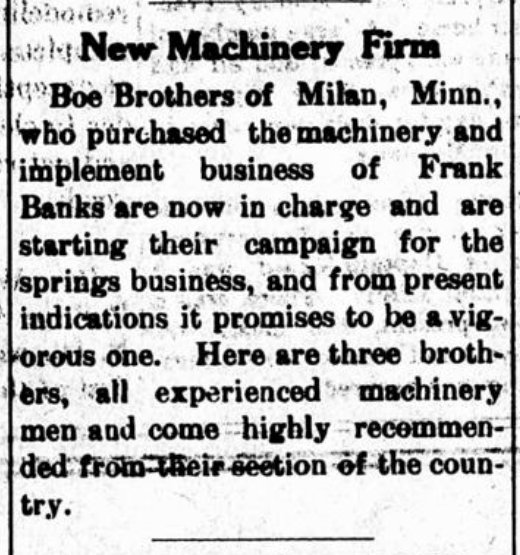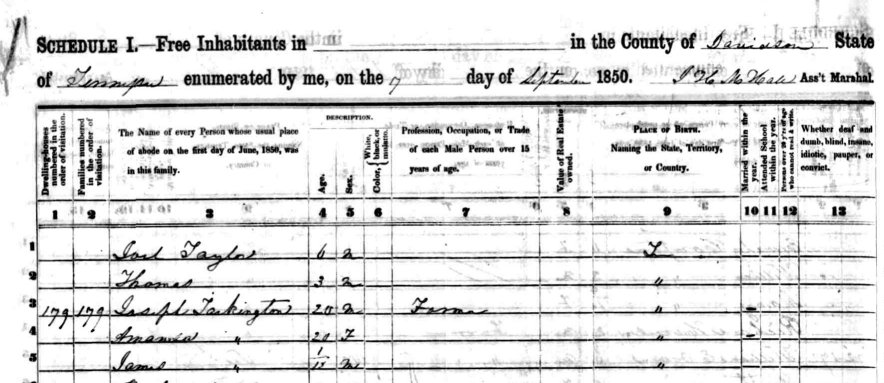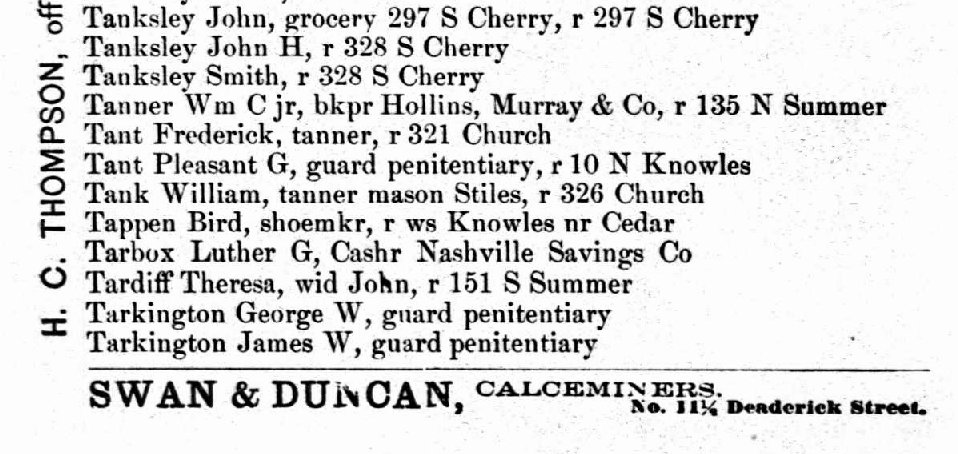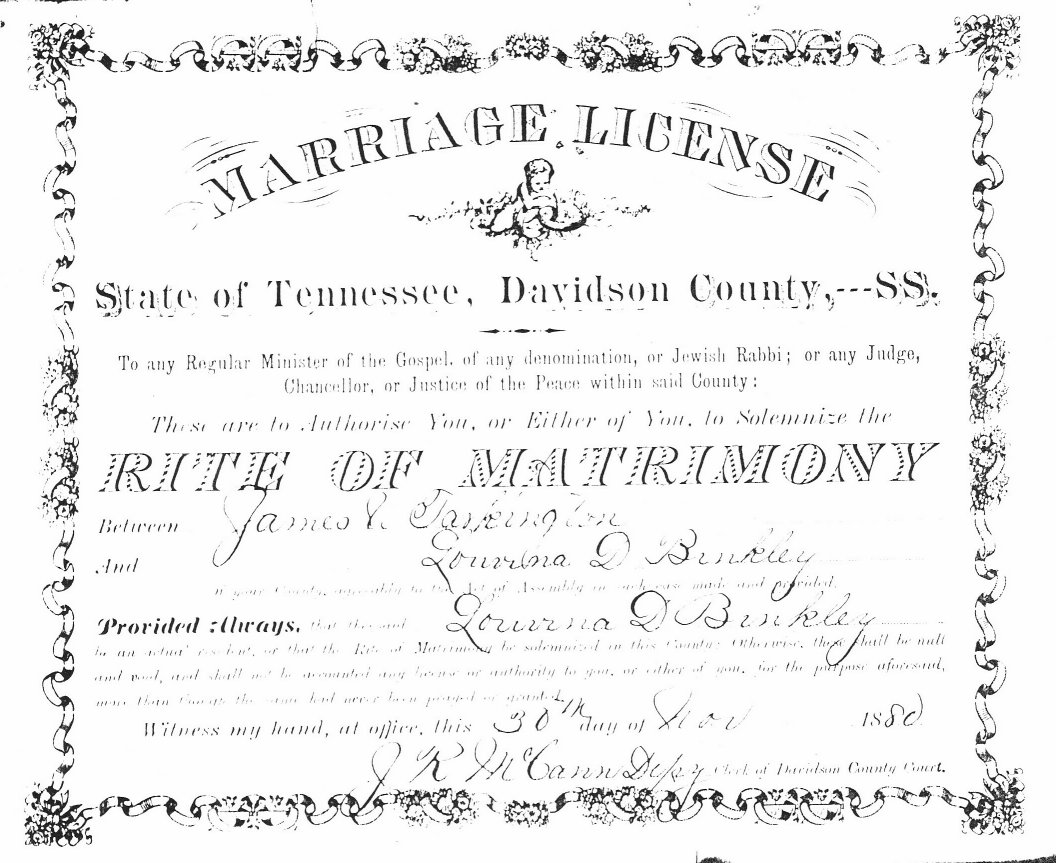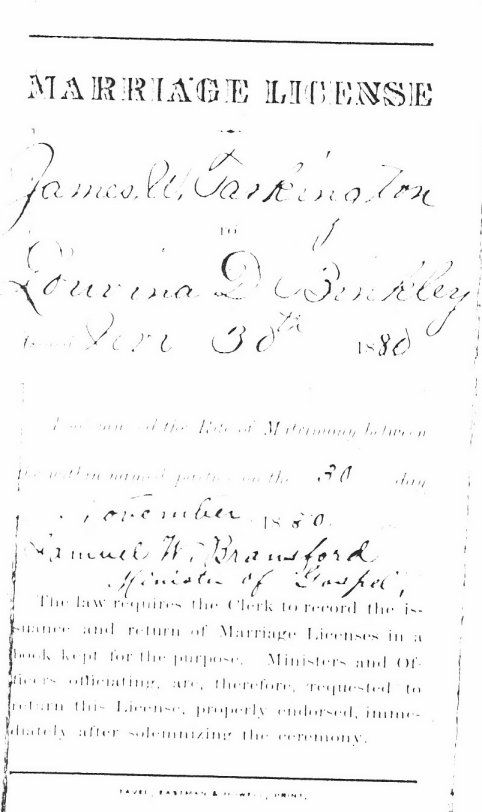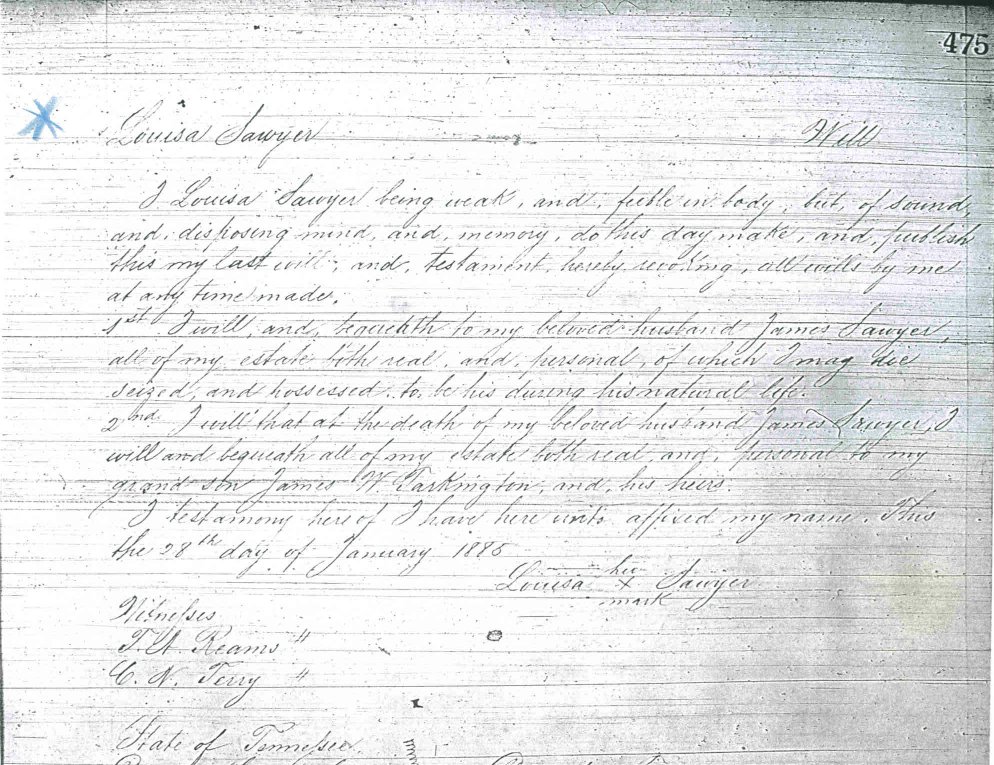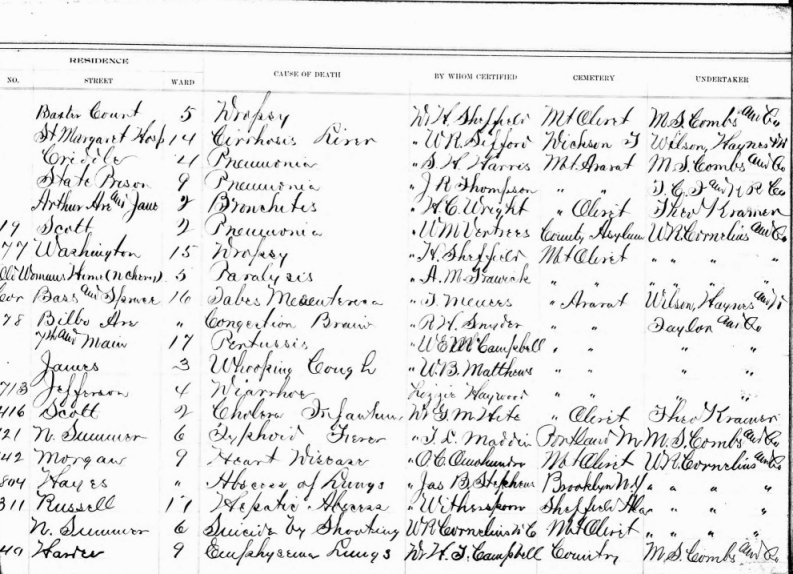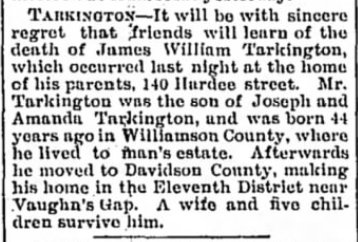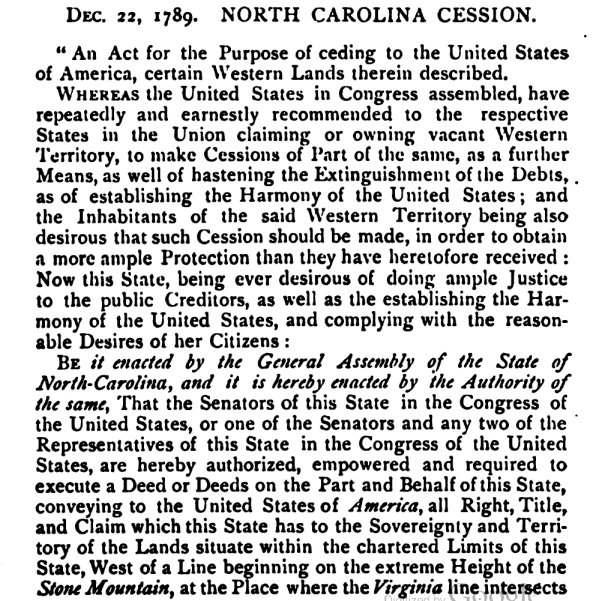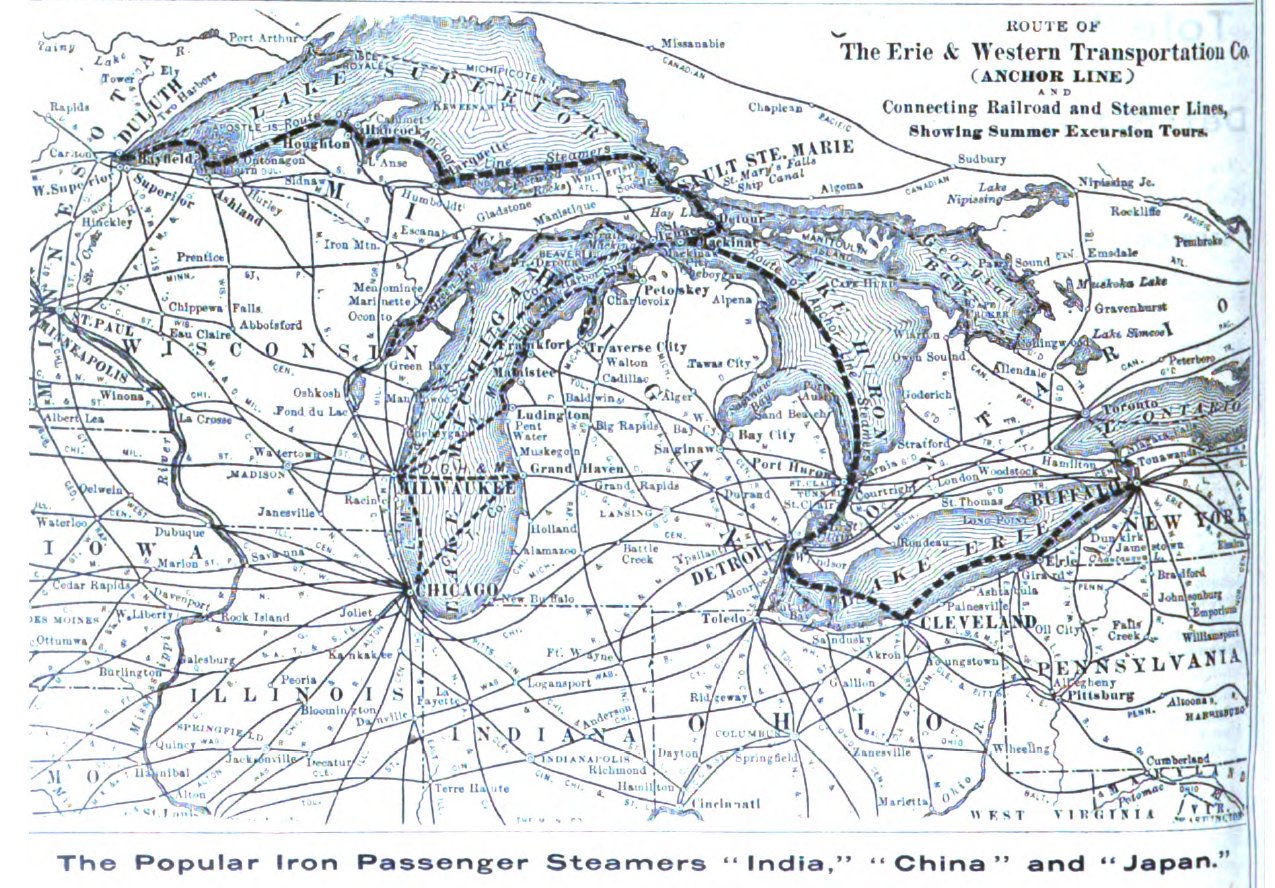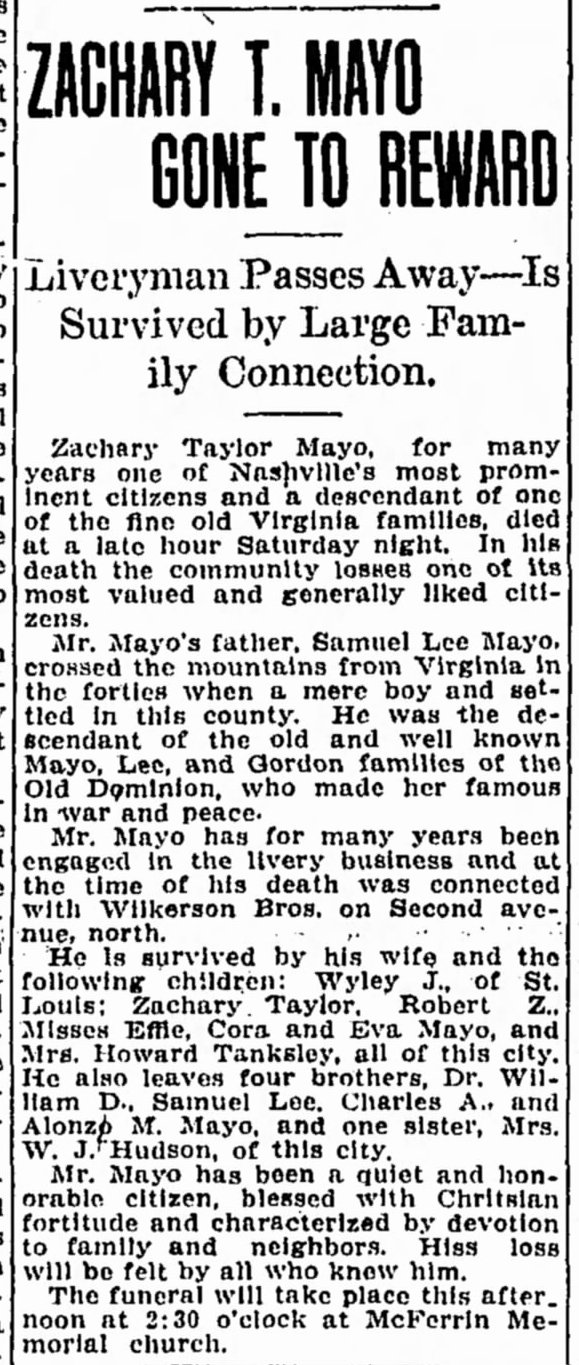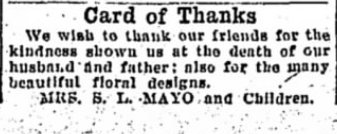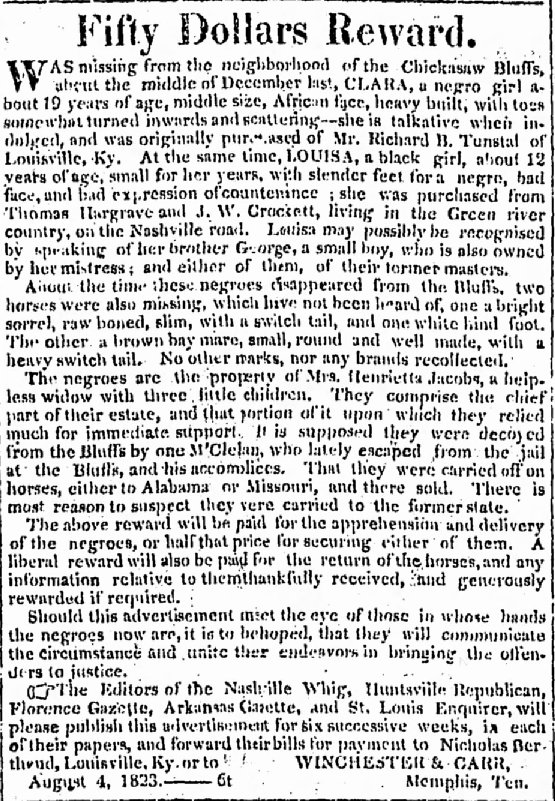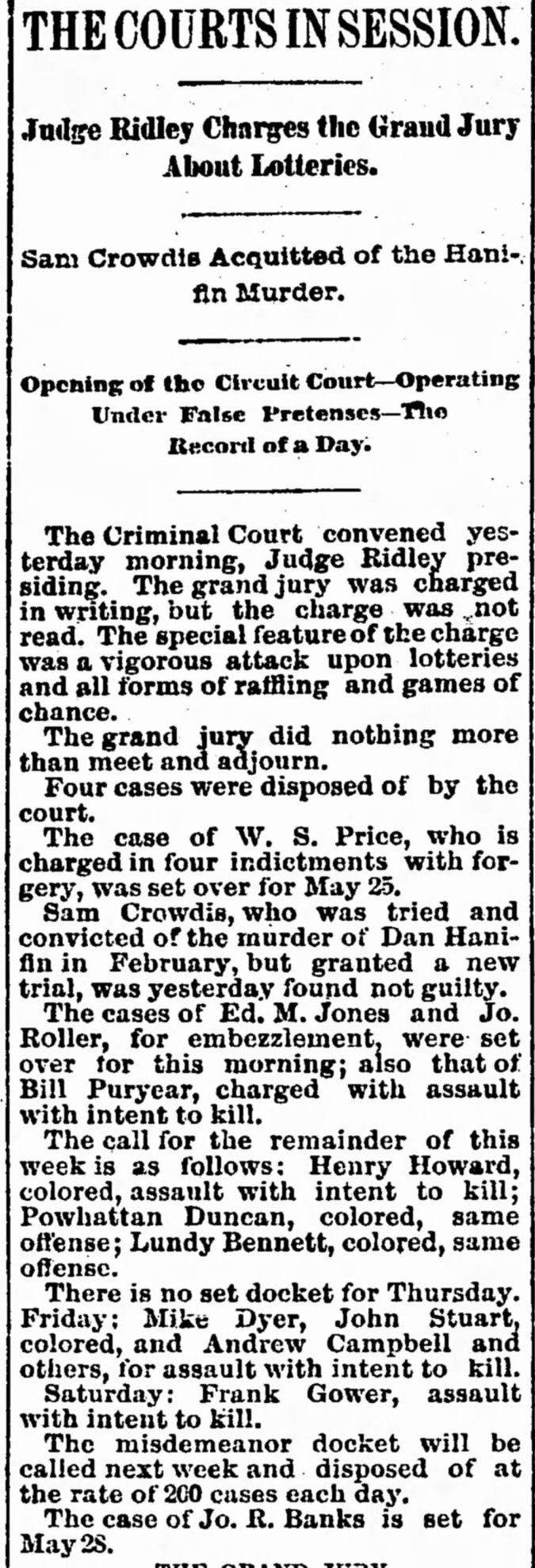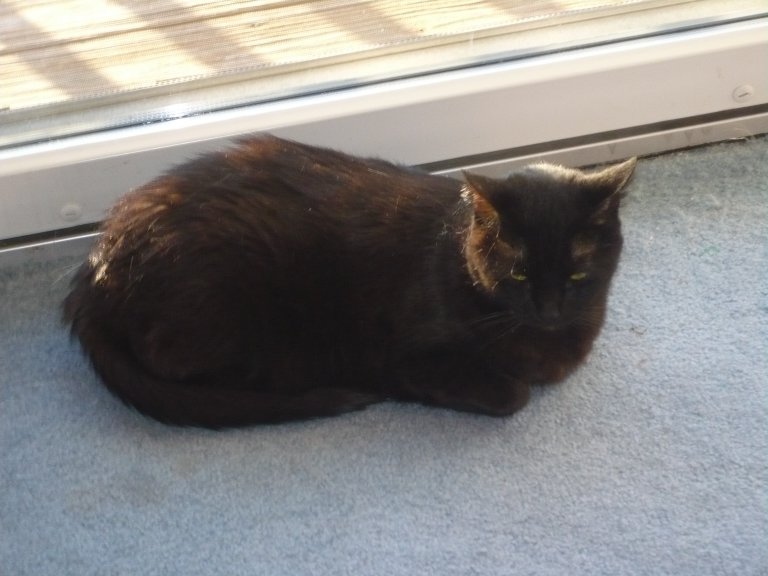Nashville Tennessean, 31 December 1922, page 12
Covering genealogy, family history, historical events and places, and anything else related!
Thursday, December 31, 2015
Wednesday, December 30, 2015
Wedding Wednesday: Eventful Time for the Cox Family
On 6 March 1899, my 2nd-great-grandmother's half-sister Nellie Cox married Owen McDonough in Davidson County, Tennessee. The March 7, 1899 issue of the Nashville American contains an announcement that the couple had obtained a marriage license.
On the same page of the newspaper, there is more news about the Cox family. Nellie's brother Tom Cox was on trial for the murder of William Freeman. It was announced that his case was continued until March 27. (It ended in a mistrial.)
Nashville American, 7 March 1899, page 5
On the same page of the newspaper, there is more news about the Cox family. Nellie's brother Tom Cox was on trial for the murder of William Freeman. It was announced that his case was continued until March 27. (It ended in a mistrial.)
Nashville American, 7 March 1899, page 5
Tuesday, December 29, 2015
52 Ancestors: Week 52 "Resolution": Andrew Russell
My 5th-great-grandfather Andrew Russell is one of my brick walls. I do not know when or where he was born, or who his parents were. Some online family trees state that he was born in 1778 in North Carolina, but I have never seen a source for this information. There were men named Andrew Russell in Augusta County, Virginia, where my Andrew Russell's wife's parents were from; I suspect that he may be related to them.
Andrew Russell married Hannah Hardgrave on 28 June 1799 in Lincoln County, Kentucky. In 1800, he lived in Pulaski County, Kentucky, which had been created from parts of Lincoln and Green Counties in December 1798.
He was one of the commissioners that helped to plan the town of Somerset (the county seat of Pulaski County) and arrange the location of public buildings such as the courthouse, jail, and stocks. (Pulaski County Fact Book II: Chapter 2: The Founding and Growth of Somerset.)
He was enumerated in Somerset in the 1810 United States census. This is the only census record that I have for him. His household consisted of 1 free white male age 26-44, 2 free white males under age 10, and 1 free white female age 26-44, 1 free white female age 10-15, and 3 free white females under age 10.
1810 United States census, Somerset, Pulaski County, Kentucky, roll 8, page 143, image 00135. Ancestry.com. 1810 United States Federal Census [database on-line]. Provo, UT, USA: Ancestry.com Operations, Inc., 2010.
Andrew was a private in Tunstall Quarles' Company of Infantry, 2nd Regiment Kentucky Volunteer Militia during the War of 1812. His regiment constructed Fort Jennings in Ohio and remained there on garrison duty. They later headed north up to Put-in-Bay, Ohio. They were sent back to Cincinnati and discharged in 1813. The 2nd Regiment Kentucky Volunteer Militia Reenactment Group's unit history provides more information on the regiment's activities.
Report of the Adjutant General of the State of Kentucky. Soldiers of the War of 1812. Printed by authority of the legislature of Kentucky. Frankfort, KY: E. Polk Johnson, 1891. Available from Internet Archive.
Compiled service record, Andrew Russell, Pvt., Tunstall Quarles' Company of Infantry, 2nd Regiment Kentucky Volunteer Militia, War of 1812. Record Group 94. National Archives, Washington, DC.
In the 1820 United States census, Andrew's wife Hannah was enumerated as head of household in Davidson County, Tennessee. Andrew may have died by 1820. I have found no further record of him.
This year I kept my resolution to obtain Andrew Russell's military records from the National Archives and Records Administration. In the coming year, I resolve to obtain land records. According to a Rootsweb family tree page for James Matthews (who rented land from Andrew Russell), Andrew Russell received two certificates for 100 and 300 acres of land on Pitman's Creek in June 1801. According to note 10, this information came from Pulaski County Order Books 1 and 2.
I will also take another look at the microfilmed Pulaski County, Kentucky tax lists at my local Family History Center. I made digital copies of the relevant pages, but some of the microfilm was very hard to read. Some of the copies are difficult to read; those pages might be a little easier to read if I go back to the microfilm. Fortunately some images, like the one below, are legible.
1800 Tax List, Pulaski County, Kentucky. Pulaski County (Kentucky). Tax Assessor. Tax books 1799-1822. Frankfort, Kentucky: Kentucky State Historical Society, 1952-1953. Family History Library microfilm 8209.
Andrew Russell married Hannah Hardgrave on 28 June 1799 in Lincoln County, Kentucky. In 1800, he lived in Pulaski County, Kentucky, which had been created from parts of Lincoln and Green Counties in December 1798.
He was one of the commissioners that helped to plan the town of Somerset (the county seat of Pulaski County) and arrange the location of public buildings such as the courthouse, jail, and stocks. (Pulaski County Fact Book II: Chapter 2: The Founding and Growth of Somerset.)
He was enumerated in Somerset in the 1810 United States census. This is the only census record that I have for him. His household consisted of 1 free white male age 26-44, 2 free white males under age 10, and 1 free white female age 26-44, 1 free white female age 10-15, and 3 free white females under age 10.
1810 United States census, Somerset, Pulaski County, Kentucky, roll 8, page 143, image 00135. Ancestry.com. 1810 United States Federal Census [database on-line]. Provo, UT, USA: Ancestry.com Operations, Inc., 2010.
Andrew was a private in Tunstall Quarles' Company of Infantry, 2nd Regiment Kentucky Volunteer Militia during the War of 1812. His regiment constructed Fort Jennings in Ohio and remained there on garrison duty. They later headed north up to Put-in-Bay, Ohio. They were sent back to Cincinnati and discharged in 1813. The 2nd Regiment Kentucky Volunteer Militia Reenactment Group's unit history provides more information on the regiment's activities.
Report of the Adjutant General of the State of Kentucky. Soldiers of the War of 1812. Printed by authority of the legislature of Kentucky. Frankfort, KY: E. Polk Johnson, 1891. Available from Internet Archive.
Compiled service record, Andrew Russell, Pvt., Tunstall Quarles' Company of Infantry, 2nd Regiment Kentucky Volunteer Militia, War of 1812. Record Group 94. National Archives, Washington, DC.
In the 1820 United States census, Andrew's wife Hannah was enumerated as head of household in Davidson County, Tennessee. Andrew may have died by 1820. I have found no further record of him.
This year I kept my resolution to obtain Andrew Russell's military records from the National Archives and Records Administration. In the coming year, I resolve to obtain land records. According to a Rootsweb family tree page for James Matthews (who rented land from Andrew Russell), Andrew Russell received two certificates for 100 and 300 acres of land on Pitman's Creek in June 1801. According to note 10, this information came from Pulaski County Order Books 1 and 2.
I will also take another look at the microfilmed Pulaski County, Kentucky tax lists at my local Family History Center. I made digital copies of the relevant pages, but some of the microfilm was very hard to read. Some of the copies are difficult to read; those pages might be a little easier to read if I go back to the microfilm. Fortunately some images, like the one below, are legible.
1800 Tax List, Pulaski County, Kentucky. Pulaski County (Kentucky). Tax Assessor. Tax books 1799-1822. Frankfort, Kentucky: Kentucky State Historical Society, 1952-1953. Family History Library microfilm 8209.
Monday, December 28, 2015
Maritime Monday: The Pursuit, Glasgow to New York, 1849
My 4th-great-grandfather Hugh Winters and most of his children (including his son John, my 3rd-great-grandfather) sailed from Glasgow, Scotland to New York, New York on the Pursuit in 1849. (His wife Mary Bennet and their daughter Margaret apparently traveled separately.)
The manifest, filled out by the ship's master Henry Evans, was dated 12 June 1849.
Passenger Lists of Vessels Arriving at New York, New York, 1820-1897. Microfilm Publication M237, 675 rolls. Records of the U.S. Customs Service, Record Group 36. National Archives at Washington, D.C. Year: 1849; Arrival: New York, New York; Microfilm Serial: M237, 1820-1897; Microfilm Roll: Roll 080; List Number: 706. Ancestry.com. New York, Passenger Lists, 1820-1957 [database on-line]. Provo, UT, USA: Ancestry.com Operations, Inc., 2010.
Passenger Lists of Vessels Arriving at New York, New York, 1820-1897. Microfilm Publication M237, 675 rolls. Records of the U.S. Customs Service, Record Group 36. National Archives at Washington, D.C. Year: 1849; Arrival: New York, New York; Microfilm Serial: M237, 1820-1897; Microfilm Roll: Roll 080; List Number: 706. Ancestry.com. New York, Passenger Lists, 1820-1957 [database on-line]. Provo, UT, USA: Ancestry.com Operations, Inc., 2010.
Passenger Lists of Vessels Arriving at New York, New York, 1820-1897. Microfilm Publication M237, 675 rolls. Records of the U.S. Customs Service, Record Group 36. National Archives at Washington, D.C. Year: 1849; Arrival: New York, New York; Microfilm Serial: M237, 1820-1897; Microfilm Roll: Roll 080; List Number: 706. Ancestry.com. New York, Passenger Lists, 1820-1957 [database on-line]. Provo, UT, USA: Ancestry.com Operations, Inc., 2010.
The 11 June 1849 issue of the New York Daily Tribune reported that the Pursuit had arrived from Glasgow.
Several British newspapers also reported the ship's arrival.
Caledonia Mercury, 28 June 1849, page 4. Available from British Newspaper Archive. Image © THE BRITISH LIBRARY BOARD. ALL RIGHTS RESERVED.
Greenock Advertiser, 29 June 1849, page 3. Available from British Newspaper Archive. Image © THE BRITISH LIBRARY BOARD. ALL RIGHTS RESERVED.
Liverpool Mail, 30 June 1849, page 7. Available from British Newspaper Archive. Image © THE BRITISH LIBRARY BOARD. ALL RIGHTS RESERVED.
Two of the newspapers reported that the Pursuit had sailed from Clyde. They must have been referring to the River Clyde.
The manifest, filled out by the ship's master Henry Evans, was dated 12 June 1849.
Passenger Lists of Vessels Arriving at New York, New York, 1820-1897. Microfilm Publication M237, 675 rolls. Records of the U.S. Customs Service, Record Group 36. National Archives at Washington, D.C. Year: 1849; Arrival: New York, New York; Microfilm Serial: M237, 1820-1897; Microfilm Roll: Roll 080; List Number: 706. Ancestry.com. New York, Passenger Lists, 1820-1957 [database on-line]. Provo, UT, USA: Ancestry.com Operations, Inc., 2010.
Passenger Lists of Vessels Arriving at New York, New York, 1820-1897. Microfilm Publication M237, 675 rolls. Records of the U.S. Customs Service, Record Group 36. National Archives at Washington, D.C. Year: 1849; Arrival: New York, New York; Microfilm Serial: M237, 1820-1897; Microfilm Roll: Roll 080; List Number: 706. Ancestry.com. New York, Passenger Lists, 1820-1957 [database on-line]. Provo, UT, USA: Ancestry.com Operations, Inc., 2010.
Passenger Lists of Vessels Arriving at New York, New York, 1820-1897. Microfilm Publication M237, 675 rolls. Records of the U.S. Customs Service, Record Group 36. National Archives at Washington, D.C. Year: 1849; Arrival: New York, New York; Microfilm Serial: M237, 1820-1897; Microfilm Roll: Roll 080; List Number: 706. Ancestry.com. New York, Passenger Lists, 1820-1957 [database on-line]. Provo, UT, USA: Ancestry.com Operations, Inc., 2010.
The 11 June 1849 issue of the New York Daily Tribune reported that the Pursuit had arrived from Glasgow.
New York Daily Tribune, 11 June 1849, page 3. Available from Chronicling America.
Several British newspapers also reported the ship's arrival.
Caledonia Mercury, 28 June 1849, page 4. Available from British Newspaper Archive. Image © THE BRITISH LIBRARY BOARD. ALL RIGHTS RESERVED.
Greenock Advertiser, 29 June 1849, page 3. Available from British Newspaper Archive. Image © THE BRITISH LIBRARY BOARD. ALL RIGHTS RESERVED.
Liverpool Mail, 30 June 1849, page 7. Available from British Newspaper Archive. Image © THE BRITISH LIBRARY BOARD. ALL RIGHTS RESERVED.
Two of the newspapers reported that the Pursuit had sailed from Clyde. They must have been referring to the River Clyde.
Sunday, December 27, 2015
Black Sheep Sunday: William D. Gatlin Robs His Own Family
Nashville Tennesseean and Nashville American, 22 September 1912
After my great-grandfather' brother William D. Gatlin escaped from jail in Bloomington, Indiana, he went to Nashville, Tennessee. He broken into the home of Walter J. Hughes and stole jewelry and $5. Although the above clipping states that W. J. Hughes was his cousin, he was actually William's uncle by marriage. Walter J. Hughes married Mary "Mollie" Dyer (William's mother's sister) on 11 February 1882.
Saturday, December 26, 2015
Sibling Saturday: New Machinery Firm - Boe Brothers
Williston Graphic, 10 February 1910, page 6
My great-grandfather John Boe and his brothers Hans Adolph Boe and Theodore Jorgen Boe started the farm machinery company Boe Brothers in 1910. The company was based in Williston, North Dakota.
Friday, December 25, 2015
Thursday, December 24, 2015
Proclamation on Guns and Fireworks, Nashville, Tennessee, 1875
Nashville Daily American, 24 December 1875, page 2
This proclamation was published in the Nashville Daily American on 24 December 1875. Firecrackers were banned, and guns were not to be fired. During Christmas Eve and Christmas Day, guns were not to be fired on the street, and firecrackers were not to be thrown on the street.
Wednesday, December 23, 2015
52 Ancestors: Week 51 "Nice": James William Tarkington
My 2nd-great-grandfather James William Tarkington was born on 28 May 1850 in Tennessee, probably in Davidson County. He was the son of Joseph Tarkington and Amanda Russell.
Joseph, Amanda and James Tarkington lived in Davidson County, Tennessee in 1850, near Amanda's family.
1850 United States census, Davidson County, Tennessee, population schedule, roll M432_875, page 279B, image 564. Ancestry.com. 1850 United States Federal Census [database on-line]. Provo, UT, USA: Ancestry.com Operations, Inc., 2009.
By 1860, the Tarkington family was living in Williamson County, Tennessee. They probably moved there in 1858 after Amanda's uncle James Russell purchased land in Williamson County as trustee for her mother Sobrina Russell.
1860 United States census, District 1, Williamson County, Tennessee, population schedule, page 98. Ancestry.com. 1860 United States Federal Census [database on-line]. Provo, UT, USA: Ancestry.com Operations, Inc., 2009.
By 1870, James was no longer living in his parents' household. He had moved in with James and Louisa Sawyer, who were living in Davidson County, Tennessee.
1870 United States census, District 11, Davidson County, Tennessee, population schedule, page 21. Ancestry.com. 1870 United States Federal Census [database on-line]. Provo, UT, USA: Ancestry.com Operations, Inc., 2009.
In 1877, James and his brother George worked as guards at the penitentiary.
Directory of Nashville, Edgefield, and Adjacent Towns in Tennessee, for 1877. Compiled by T. M. Haddock. Nashville: Tavel, Eastman & Howell. Page 348. Ancestry.com. U.S. City Directories, 1822-1995 [database on-line]. Provo, UT, USA: Ancestry.com Operations, Inc., 2011.
In 1880, James was still living with James and Louisa Sawyer, but this census revealed something new: his relationship to the head of the household was "Gr. son." Since James and Louisa had married in 1845, James Tarkington could not be the son of a child that they had together. When I first came across this record, my first thought was of the family tree in my father's baby book, which stated that James William Tarkington's mother was Amanda Sawyer. Although Louisa (McDowell) Sawyer's previous husband was Asbury Tarkington, they married in 1832, and Joseph Tarkington was born in 1830. Since Joseph Tarkington married Amanda Russell in 1849, I think that the birth year of 1830 is likely to be correct. For further analysis, see my posts on Amanda Russell and Joseph Tarkington.
1880 United States census, Fourteenth District, Davidson County, Tennessee, population schedule, page 5. Ancestry.com and The Church of Jesus Christ of Latter-day Saints. 1880 United States Federal Census [database on-line]. Provo, UT, USA: Ancestry.com Operations Inc, 2010.
James married Anna Malvina Binkley (listed as Louvina D. Binkley on their marriage license; I have found so many variant forms of her name!) on 30 November 1880. They were married by Samuel W. Bransford, Minister of the Gospel.
Davidson County, Tennessee marriage license, James W. Tarkington and Louvina D. Binkley. 30 November 1880. Nashville, Tennessee: Metropolitan Government Archives.
Davidson County, Tennessee marriage license, James W. Tarkington and Louvina D. Binkley. 30 November 1880. Nashville, Tennessee: Metropolitan Government Archives.
James and Anna had five children: Laura Belle Tarkington (born 27 August 1881), Mary Magdalene or Margaret Tarkington (born 15 February 1884), Viola Maydell Tarkington (born 15 September 1886), my great-grandmother Anna Gertrude Tarkington (born 16 April 1889), and Robert Vaughn Tarkington (born 15 December 1892).
In 1885, Louisa Sawyer wrote her will. She left her estate to her husband James Sawyer, and specified that after his death, it was to go to her grandson James W. Tarkington. None of Joseph and Amanda Tarkington's other children were mentioned in the will. If James W. Tarkington was her biological grandchild, his siblings would be too. It seems far more likely that she would leave her property to a step-grandson that had lived with her for at least ten years and who she probably had come to think of as a grandson, than that she would disinherit her son and all but one of her grandchildren.
James William Tarkington died at his parents' home in Nashville on 12 June 1894. The cause of death was emphysema. He was buried at the J. R. Binkley Cemetery in Vaughn's Gap.
Davidson County, Tennessee death registers, June 1894. No. 653, James Tarkington. (Side 1). Ancestry.com. Tennessee, City Death Records, 1872-1923 [database on-line]. Provo, UT, USA: Ancestry.com Operations, Inc., 2012.Original data: Tennessee City Death Records, Nashville, Knoxville, Chattanooga, Memphis, 1848-1907. Nashville, Tennessee: Tennessee State Library and Archives.
Davidson County, Tennessee death registers, June 1894. No. 653, James Tarkington. (side 2). Ancestry.com. Tennessee, City Death Records, 1872-1923 [database on-line]. Provo, UT, USA: Ancestry.com Operations, Inc., 2012.Original data: Tennessee City Death Records, Nashville, Knoxville, Chattanooga, Memphis, 1848-1907. Nashville, Tennessee: Tennessee State Library and Archives.
It was nice of James William Tarkington to live with his grandparents (biological and step) for so many years. He was probably very helpful to them. His step-grandmother seems to have loved him as her own grandson. And the documentary evidence of this living arrangement provided me with important clues that helped me to identify his mother's father. That was very nice too!
From family group sheet compiled by P. C. Lampley, 12 December 1983.
Joseph, Amanda and James Tarkington lived in Davidson County, Tennessee in 1850, near Amanda's family.
1850 United States census, Davidson County, Tennessee, population schedule, roll M432_875, page 279B, image 564. Ancestry.com. 1850 United States Federal Census [database on-line]. Provo, UT, USA: Ancestry.com Operations, Inc., 2009.
By 1860, the Tarkington family was living in Williamson County, Tennessee. They probably moved there in 1858 after Amanda's uncle James Russell purchased land in Williamson County as trustee for her mother Sobrina Russell.
1860 United States census, District 1, Williamson County, Tennessee, population schedule, page 98. Ancestry.com. 1860 United States Federal Census [database on-line]. Provo, UT, USA: Ancestry.com Operations, Inc., 2009.
By 1870, James was no longer living in his parents' household. He had moved in with James and Louisa Sawyer, who were living in Davidson County, Tennessee.
1870 United States census, District 11, Davidson County, Tennessee, population schedule, page 21. Ancestry.com. 1870 United States Federal Census [database on-line]. Provo, UT, USA: Ancestry.com Operations, Inc., 2009.
In 1877, James and his brother George worked as guards at the penitentiary.
Directory of Nashville, Edgefield, and Adjacent Towns in Tennessee, for 1877. Compiled by T. M. Haddock. Nashville: Tavel, Eastman & Howell. Page 348. Ancestry.com. U.S. City Directories, 1822-1995 [database on-line]. Provo, UT, USA: Ancestry.com Operations, Inc., 2011.
In 1880, James was still living with James and Louisa Sawyer, but this census revealed something new: his relationship to the head of the household was "Gr. son." Since James and Louisa had married in 1845, James Tarkington could not be the son of a child that they had together. When I first came across this record, my first thought was of the family tree in my father's baby book, which stated that James William Tarkington's mother was Amanda Sawyer. Although Louisa (McDowell) Sawyer's previous husband was Asbury Tarkington, they married in 1832, and Joseph Tarkington was born in 1830. Since Joseph Tarkington married Amanda Russell in 1849, I think that the birth year of 1830 is likely to be correct. For further analysis, see my posts on Amanda Russell and Joseph Tarkington.
1880 United States census, Fourteenth District, Davidson County, Tennessee, population schedule, page 5. Ancestry.com and The Church of Jesus Christ of Latter-day Saints. 1880 United States Federal Census [database on-line]. Provo, UT, USA: Ancestry.com Operations Inc, 2010.
James married Anna Malvina Binkley (listed as Louvina D. Binkley on their marriage license; I have found so many variant forms of her name!) on 30 November 1880. They were married by Samuel W. Bransford, Minister of the Gospel.
Davidson County, Tennessee marriage license, James W. Tarkington and Louvina D. Binkley. 30 November 1880. Nashville, Tennessee: Metropolitan Government Archives.
Davidson County, Tennessee marriage license, James W. Tarkington and Louvina D. Binkley. 30 November 1880. Nashville, Tennessee: Metropolitan Government Archives.
James and Anna had five children: Laura Belle Tarkington (born 27 August 1881), Mary Magdalene or Margaret Tarkington (born 15 February 1884), Viola Maydell Tarkington (born 15 September 1886), my great-grandmother Anna Gertrude Tarkington (born 16 April 1889), and Robert Vaughn Tarkington (born 15 December 1892).
In 1885, Louisa Sawyer wrote her will. She left her estate to her husband James Sawyer, and specified that after his death, it was to go to her grandson James W. Tarkington. None of Joseph and Amanda Tarkington's other children were mentioned in the will. If James W. Tarkington was her biological grandchild, his siblings would be too. It seems far more likely that she would leave her property to a step-grandson that had lived with her for at least ten years and who she probably had come to think of as a grandson, than that she would disinherit her son and all but one of her grandchildren.
Will of Louisa Sawyer, 28 January 1885.
James William Tarkington died at his parents' home in Nashville on 12 June 1894. The cause of death was emphysema. He was buried at the J. R. Binkley Cemetery in Vaughn's Gap.
Davidson County, Tennessee death registers, June 1894. No. 653, James Tarkington. (Side 1). Ancestry.com. Tennessee, City Death Records, 1872-1923 [database on-line]. Provo, UT, USA: Ancestry.com Operations, Inc., 2012.Original data: Tennessee City Death Records, Nashville, Knoxville, Chattanooga, Memphis, 1848-1907. Nashville, Tennessee: Tennessee State Library and Archives.
Davidson County, Tennessee death registers, June 1894. No. 653, James Tarkington. (side 2). Ancestry.com. Tennessee, City Death Records, 1872-1923 [database on-line]. Provo, UT, USA: Ancestry.com Operations, Inc., 2012.Original data: Tennessee City Death Records, Nashville, Knoxville, Chattanooga, Memphis, 1848-1907. Nashville, Tennessee: Tennessee State Library and Archives.
Daily American, 13 June 1894, page 5
Nashville Banner, 13 June 1894
It was nice of James William Tarkington to live with his grandparents (biological and step) for so many years. He was probably very helpful to them. His step-grandmother seems to have loved him as her own grandson. And the documentary evidence of this living arrangement provided me with important clues that helped me to identify his mother's father. That was very nice too!
Tuesday, December 22, 2015
North Carolina Cedes Six Western Counties
American History Leaflets: Colonial and Constitutional. Edited by Albert Bushnell Hart and Edward Channing. No. 22 (July 1895). New York: A. Lovell & Company. Page 26. Available from Google Books.
On 22 December 1789, North Carolina ceded six western counties to the Continental Congress. These counties had been part of the state of Franklin, and had returned to North Carolina once Franklin dissolved. These counties became the Southwest Territory, which became the state of Tennessee.
References
Southwest Territory
The State of Franklin and Tennessee Aborning
On 22 December 1789, North Carolina ceded six western counties to the Continental Congress. These counties had been part of the state of Franklin, and had returned to North Carolina once Franklin dissolved. These counties became the Southwest Territory, which became the state of Tennessee.
References
Southwest Territory
The State of Franklin and Tennessee Aborning
Monday, December 21, 2015
Mappy Monday: Route of the Erie & Western Transportation Co. (Anchor Line)
Route of the Erie & Western Transportation Co. (Anchor Line) and connecting railroad and steamer lines, showing summer excursion tours. Traveler's Official Guide of the Railway and Steam Navigation Lines in the United States, Canada, and Mexico. New York: National Railway Publication Co. 32nd year, no. 10. March 1900. Page 462. Available from Google Books.
This map shows the route of the Erie & Western Transportation Co. (Anchor Line), as well as connecting lines (both railroad and steamer). Passengers could travel from Buffalo, New York; Erie, Pennsylvania; Cleveland, Ohio; and Detroit, Michigan to the summer resorts. They could connect at Mackinac Island and then take steamer lines.
I found this map interesting because it gave me an idea of how my ancestors John and Ann (Walker) Winters and their daughter Elizabeth may have traveled from Tonawanda, New York to Chicago, Illinois.
This map shows the route of the Erie & Western Transportation Co. (Anchor Line), as well as connecting lines (both railroad and steamer). Passengers could travel from Buffalo, New York; Erie, Pennsylvania; Cleveland, Ohio; and Detroit, Michigan to the summer resorts. They could connect at Mackinac Island and then take steamer lines.
I found this map interesting because it gave me an idea of how my ancestors John and Ann (Walker) Winters and their daughter Elizabeth may have traveled from Tonawanda, New York to Chicago, Illinois.
Sunday, December 20, 2015
Sunday's Obituary: Zachary T. Mayo
Nashville Tennessean, 9 September 1907, page 9
ZACHARY T. MAYO
GONE TO REWARD
––––––––––––––––
Liveryman Passes Away – Is Survived by Large Family Connection.
––––––––––––––––
Zachary Taylor Mayo, for many years one of Nashville's most prominent citizens and a descendant of one of the fine old Virginia families, died at a late hour Saturday night. In his death the community losses [sic] one of its most valued and generally liked citizens.Mr. Mayo's father, Samuel Lee Mayo, crossed the mountains from Virginia in the forties when a mere boy and settled in this county. He was the descendant of the old and well known Mayo, Lee, and Gordon families of the Old Dominion, who made her famous in war and peace.
Mr. Mayo has for many years been engaged in the livery business and at the time of his death was connected with Wilkerson Bros. on Second avenue, north.
He is survived by his wife and the following children: Wyley J. of St. Louis; Zachary Taylor, Robert Z., Mises Effie, Cora, and Eva Mayo, and Mrs. Howard Tanksley, all of this city. He also leaves four brothers, Dr. William D., Samuel Lee, Charles A., and Alonzo M. Mayo, and one sister, Mrs. W. J. Hudson, of this city.
Mr. Mayo has been a quiet and honorable citizen, blessed with Chritsian [sic] fortitude and characterized by devotion to family and neighbors. Hiss [sic] loss will be felt by all who knew him.
The funeral will take place this afternoon at 2:30 o'clock at McFerrin Memorial church.
––––––––––––––––––––––––––––––––––––––––––––––––––––––––––––––––
Zachary Taylor Mayo was the son of Stephen Lee Mayo and Amanda Ezell. He married Julia Frances Walker on 11 December 1873 in Yalobusha County, Mississippi.
Zachary's father Stephen Lee Mayo was the brother of my 3rd-great-grandmother Angeline Mayo. Their parents were Jacob Dillard Mayo and Eliza Gordon. This obituary gives me a helpful clue. I know that Eliza's father was Chapman Gordon, but I don't know anything else about her ancestry. Maybe Chapman Gordon's unknown first wife was a Lee.
Jacob D. Mayo's household was enumerated in Davidson County, Tennessee in the 1840 United States Census. Samuel Lee Mayo probably "crossed the mountains from Virginia" in the thirties, not the forties.
Saturday, December 19, 2015
Sympathy Saturday: Card of Thanks, Mrs. S. L. Mayo and Children
Nashville Tennessean, 5 February 1922, page 16
Stephen Lee Mayo, the son of my 3rd-great-grandmother's brother Stephen Lee Mayo and Tabitha Elizabeth Riggan, died on 29 January 1922 in Nashville, Tennessee. His widow Mary Ellen (Hudson) Mayo and their children published a card of thanks in the Nashville Tennessean.
Friday, December 18, 2015
Friend of Friends Friday: Slaves of Mrs. Henrietta Jacobs Missing from the Chickasaw Bluffs, Tennessee
Nashville Whig, 18 August 1823, page 4
Fifty Dollars Reward.
WAS missing from the neighborhood of the Chickasaw Bluffs, about the middle of December last, CLARA, a negro girl about 19 years of age, middle size, African face, heavy built, with toes somewhat turned inwards and scattering--she is talkative when indulged, and was originally purchased of Mr. Richard B. Tunstal of Louisville, Ky. At the same time, LOUISA, a black girl, about 12 years of age, small for her years, with slender feet for a negro, bad face, and bad expression of countenance ; she was purchased from Thomas Hargrave and J. W. Crockett, living in the Green river country, on the Nashville road. Louisa may possibly be recognized by speaking of her brother George, a small boy, who is also owned by her mistress; and either of them, of their former masters.
About the time these negroes disappeared from the Bluffs, two horses were also missing, which have not been heard of, one a bright sorrel, raw boned, slim with a switch tail, and one white hind foot. The other a brown bay mare, small, round, and well made, with a heavy switch tail. No other marks, nor any brands recollected.
The negroes are the property of Mrs. Henrietta Jacobs, a helpless widow with three little children. They comprise the chief part of their estate, and that portion of it on which they relied much for immediate support. It is supposed they were decoyed from the Bluffs by one M'Clelan, who lately escaped from the jail at the Bluffs, and his accomplices. That they were carried off on horses, either to Alabama or Missouri, and there sold. There is most reason to suspect they were carried to the former state.
The above reward will be paid for the apprehension and delivery of the negroes, or half that price for securing either of them. A liberal reward will also be paid for the return of the horses, and any information relative to them thankfully received, and generously rewarded if required.
Should this advertisement meet the eye of those in whose hands the negroes now are, it is to be hoped, that they will communicate the circumstance and unite their endeavors in bringing the offenders to justice.
☞The editors of the Nashville Whig, Huntsville Republican, Florence Gazette, Arkansas Gazette, and St. Louis Enquirer, will please publish this advertisement for six successive weeks, in each of their papers, and forward their bills for payment to Nicholas Berthend, Louisville, Ky. or to
WINCHESTER & CARR,
August 4. 1823.––––6t Memphis, Ten.
Thursday, December 17, 2015
Wright Brothers Day
December 17 is Wright Brothers Day. It commemorates the first flight made in a mechanically propelled craft, which was made by Orville and Wilbur Wright on 17 December 1903. There is an annual presidential proclamation.
Some of my ancestors may have read this account of the Wright brothers' flight, which was published in the Nashville American.
Some of my ancestors may have read this account of the Wright brothers' flight, which was published in the Nashville American.
Nashville American, 19 December 1903, page 3
Wednesday, December 16, 2015
52 Ancestors: Week 50 "Naughty": Michael J. Dyer
Many members of my family would be good choices for this week's 52 Ancestors theme, "Naughty." I have written about many of them already. I keep finding more and more "black sheep." This week I will focus on my 2nd-great-grandmother's brother Michael J. "Mike" Dyer, who only recently was added to the "naughty list" of relatives after I did more research in newspapers.
Mike was born about 1868 in Tennessee, probably Nashville (his family's place of residence). He was the son of Irish immigrants Mary and Michael Dyer. In 1870, Mike's father committed suicide. His mother remarried John Cox in 1871, but was widowed in 1878.
In 1884, Mike and his friends Patrick Kane and David Hanley (or Harley) ran away from home. Mike stole $40 from his mother's grocery store and got on a train in Nashville. They stopped at Louisville, Kentucky to buy revolvers, and then got off the train in Cincinnati, Ohio. They wanted to go West. They had been reading about Jesse James and Buffalo Bill, and wanted to scalp Indians and experience the Wild West. But they were hungry and broke, so they tried to sell their guns, and were arrested. Telegraphs were sent to their families.
The "Bound for the Plains" article, which was published in the 17 April 1884 issue of the Cincinnati Enquirer,was reprinted in the Nashville newspaper Daily American, 18 April 1884.
In May 1888, Mike was charged with assault with intent to kill.
In February 1892, Mike shot at William Dunn, who was engaged in a fight with Dave Farrell, and one of the bullets hit Dunn's thigh. Mike's half-brother Tom Cox then whipped out a knife and cut Dunn's neck.
Shortly afterward, Mike appeared in City Court on the charges of assault with and carrying a pistol and shooting in corporate limits.
In 1893, Mike was charged with carrying weapons.
In September 1894, Mike was arrested for gaming and was fined $10.
On December 12, 1895, Mike and Charles Neyman got into a fight. Charles, who claimed that Mike started the fight, hit Mike on the head with a hammer. Mike's skull was fractured, and several pieces of bone had to be removed. It was reported that he would recover.
However, on 24 December 1895, Mike died at his mother's home.
Two days after Mike's death notice was published, an item appeared in the newspaper which provided more information. Mike died of "congestion of brain." He must have died as a result of the blow on his head. I wonder if Charles Neylan was charged with murder. He should have been.
Mike's half-brother William Cox died on 2 March 1896. When William was buried, Mike's body was removed from a vault and buried at the same time.
Mike was born about 1868 in Tennessee, probably Nashville (his family's place of residence). He was the son of Irish immigrants Mary and Michael Dyer. In 1870, Mike's father committed suicide. His mother remarried John Cox in 1871, but was widowed in 1878.
In 1884, Mike and his friends Patrick Kane and David Hanley (or Harley) ran away from home. Mike stole $40 from his mother's grocery store and got on a train in Nashville. They stopped at Louisville, Kentucky to buy revolvers, and then got off the train in Cincinnati, Ohio. They wanted to go West. They had been reading about Jesse James and Buffalo Bill, and wanted to scalp Indians and experience the Wild West. But they were hungry and broke, so they tried to sell their guns, and were arrested. Telegraphs were sent to their families.
Daily American (Nashville, TN), 17 April 1884, page 4
The "Bound for the Plains" article, which was published in the 17 April 1884 issue of the Cincinnati Enquirer,was reprinted in the Nashville newspaper Daily American, 18 April 1884.
Cincinnati Enquirer, 17 April 1884, page 4
In May 1888, Mike was charged with assault with intent to kill.
Daily American (Nashville, TN), 8 May 1888, page 4
In February 1892, Mike shot at William Dunn, who was engaged in a fight with Dave Farrell, and one of the bullets hit Dunn's thigh. Mike's half-brother Tom Cox then whipped out a knife and cut Dunn's neck.
Daily American (Nashville. TN), 27 February 1892, page 3
Shortly afterward, Mike appeared in City Court on the charges of assault with and carrying a pistol and shooting in corporate limits.
Daily American (Nashville, TN), 1 March 1892, page 3
In 1893, Mike was charged with carrying weapons.
Daily American (Nashville, TN), 6 September 1893, page 4
In September 1894, Mike was arrested for gaming and was fined $10.
Nashville Daily American, 11 September 1894, page 6
On December 12, 1895, Mike and Charles Neyman got into a fight. Charles, who claimed that Mike started the fight, hit Mike on the head with a hammer. Mike's skull was fractured, and several pieces of bone had to be removed. It was reported that he would recover.
Nashville American, 14 December 1895, page 6
However, on 24 December 1895, Mike died at his mother's home.
Nashville American, 25 December 1895, page 5
Two days after Mike's death notice was published, an item appeared in the newspaper which provided more information. Mike died of "congestion of brain." He must have died as a result of the blow on his head. I wonder if Charles Neylan was charged with murder. He should have been.
Nashville American, 27 December 1895, page 5
Mike's half-brother William Cox died on 2 March 1896. When William was buried, Mike's body was removed from a vault and buried at the same time.
Nashville American, 3 March 1896, page 4
Labels:
52 Ancestors,
Black sheep,
Cox,
Dyer,
Kentucky,
Nashville,
Ohio,
Tennessee
Tuesday, December 15, 2015
Cat Herders Day
December 15 is Cat Herders Day. The day is for people who feel that they are trying to do the impossible, as if they were herding cats.
In a way, I literally herd cats twice a day, every day. I have six cats: Jewel, Harmony, Melody, Luna, Kit, and Flash. Feeding time is herding time. I feed only canned food. Jewel, my oldest, is on a prescription diet because of her kidney insufficiency. Flash, my youngest and the alpha cat, has to eat alone because he will eat the other cats' food. He will start eating from one bowl, and then quickly switch to another, so no one else can eat in peace. So my six cats eat in three rooms.
I look around to see where the cats are. If I see them all and none of them are in my bedroom, I pick up Flash, put him in my bedroom, and close the door. Sometimes other cats are in the bedroom, though. It is usually one or more of the three littermates (Harmony, Melody, and Luna.) If I cannot get them out of the bedroom, I pick up Flash and put him into the small bathroom off my bedroom and close the door.
I then get Jewel to go into one of the spare bedrooms. Sometimes I pick her up, but often she will go there on her own.
Harmony, Melody, Luna, and Kit go into the kitchen, eagerly awaiting their food. I put all six bowls on the counter, pick up the cans of food and open them, and begin scooping the food into the bowls. As I do this, I try to keep Kit, who has climbed onto the counter, from getting at the food until the bowls are ready to go and placed on the floor. I tell him "Wait until you're served!" I put two bowls on the kitchen floor. Kit immediately jumps off the counter and claims one of them. Harmony quickly moves to one as well; she usually gets the one on the far right. I then put two more bowls on the kitchen floor, and Melody and Luna begin eating.
Kit, Luna, Melody, and Harmony. Kit hadn't fully gotten over his shyness at the time this photo was taken; he had not yet started climbing on the counter to try to get the food and he was not yet claiming one of the first bowls.
I then pick up the remaining two bowls. I bring the bowl of Hill's Prescription k/d to Jewel. I then bring the remaining bowl to my bedroom for Flash. If he is in the bathroom, I let him out. Even though I feed him last, he will not necessarily be the last to finish eating; he inhales his food!
In the morning, I let Jewel and Flash out after everyone has finished eating. In the evening, I let Jewel out after all the cats are done eating, but Flash has to stay in the bedroom until I am done with dinner. He tries to steal my food too!
In a way, I literally herd cats twice a day, every day. I have six cats: Jewel, Harmony, Melody, Luna, Kit, and Flash. Feeding time is herding time. I feed only canned food. Jewel, my oldest, is on a prescription diet because of her kidney insufficiency. Flash, my youngest and the alpha cat, has to eat alone because he will eat the other cats' food. He will start eating from one bowl, and then quickly switch to another, so no one else can eat in peace. So my six cats eat in three rooms.
I look around to see where the cats are. If I see them all and none of them are in my bedroom, I pick up Flash, put him in my bedroom, and close the door. Sometimes other cats are in the bedroom, though. It is usually one or more of the three littermates (Harmony, Melody, and Luna.) If I cannot get them out of the bedroom, I pick up Flash and put him into the small bathroom off my bedroom and close the door.
Flash
I then get Jewel to go into one of the spare bedrooms. Sometimes I pick her up, but often she will go there on her own.
Jewel
Harmony, Melody, Luna, and Kit go into the kitchen, eagerly awaiting their food. I put all six bowls on the counter, pick up the cans of food and open them, and begin scooping the food into the bowls. As I do this, I try to keep Kit, who has climbed onto the counter, from getting at the food until the bowls are ready to go and placed on the floor. I tell him "Wait until you're served!" I put two bowls on the kitchen floor. Kit immediately jumps off the counter and claims one of them. Harmony quickly moves to one as well; she usually gets the one on the far right. I then put two more bowls on the kitchen floor, and Melody and Luna begin eating.
Kit, Luna, Melody, and Harmony. Kit hadn't fully gotten over his shyness at the time this photo was taken; he had not yet started climbing on the counter to try to get the food and he was not yet claiming one of the first bowls.
I then pick up the remaining two bowls. I bring the bowl of Hill's Prescription k/d to Jewel. I then bring the remaining bowl to my bedroom for Flash. If he is in the bathroom, I let him out. Even though I feed him last, he will not necessarily be the last to finish eating; he inhales his food!
In the morning, I let Jewel and Flash out after everyone has finished eating. In the evening, I let Jewel out after all the cats are done eating, but Flash has to stay in the bedroom until I am done with dinner. He tries to steal my food too!
Subscribe to:
Posts (Atom)

